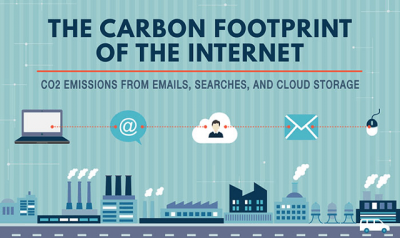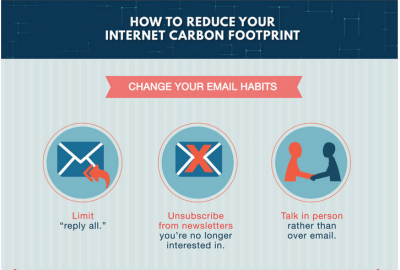Difference between revisions of "The Internet's Footprint"
(→End-user equipment) |
(→Cryptocurrencies) |
||
| Line 24: | Line 24: | ||
===Cryptocurrencies=== | ===Cryptocurrencies=== | ||
| − | [[File:Bitcoin.png|350px|thumbnail|This graph shows Bitcoin's power usage worldwide over time. <ref name=digi></ref>]] Another major source of the Internet’s carbon footprint is the rise of cryptocurrencies. The last 12 years have seen the invention and rise in popularity of blockchain based cryptocurrencies such as [[ | + | [[File:Bitcoin.png|350px|thumbnail|This graph shows Bitcoin's power usage worldwide over time. <ref name=digi></ref>]] Another major source of the Internet’s carbon footprint is the rise of cryptocurrencies. The last 12 years have seen the invention and rise in popularity of blockchain based cryptocurrencies such as [[https://www-sciencedirect-com.proxy.lib.umich.edu/science/article/pii/S0165176516303640?via%3Dihub|Bitcoin]], however the methods of obtaining and using these digital currencies require massive amounts of energy use. The main energy cost involved is maintaining the blockchain, the network that verifies all the transactions, between all users of a currency. <ref name=finex>Soni, S. (2021, March 18). Bitcoin shocker: CRYPTO'S rise may soon LEAVE carbon footprint equivalent to size of LONDON'S emissions. Retrieved March 25, 2021, from https://www.financialexpress.com/industry/bitcoin-shocker-cryptos-rise-may-soon-leave-carbon-footprint-equivalent-to-size-of-londons-emissions/2215513/</ref> For most cryptos this involves users completing complex mathematical calculations using a computer, either their personal devices or dedicated mining machines. These computations draw significant amounts of energy, to the point that a single transaction for Bitcoin uses 359.04 kgCO2, which is over 700,000 times more than the average credit card transaction. <ref>Laurent, L. (2021, January 26). Bitcoin Is an Incredibly Dirty Business. Retrieved March 25, 2021, from https://www.bloomberg.com/opinion/articles/2021-01-26/is-bitcoin-mining-worth-the-environmental-cost</ref> All in all current estimates put the worldwide annual power consumption of just Bitcoin at 87.17 TWh, roughly the same as the country of Finland. <ref name=digi>Bitcoin energy consumption index. (2021, March 10). Retrieved March 25, 2021, from https://digiconomist.net/bitcoin-energy-consumption/</ref> The problems related to this are compounded by the fact that most crypto mining happens in regions of the world still reliant on non-renewable energy, namely China. <ref name=digi></ref> This relationship to non-renewables goes as far as speculation that oil and gas companies could dominate the cryptomining industry in the near future due to their easy access to cheap power. <ref>Jenkinson, G. (2020, April 28). Eco-Friendly crypto mining is the future as green solutions gain steam. Retrieved March 25, 2021, from https://cointelegraph.com/news/eco-friendly-crypto-mining-is-the-future-as-green-solutions-gain-steam</ref> |
. | . | ||
Revision as of 15:27, 26 March 2021
An environmental footprint, also known as an ecological footprint, is a measurement of the effects a company, person, or activity has on the environment. It is measured by considering the multiple impacts certain activities and industries have on water, land, air, carbon release, etc. [1] For example, ecologists will measure qualities such as the amount of waste produced or how many non-renewable resources used up to determine the environmental footprint it left on the planet. The Internet and it's digital technologies are believed to be accountable for 3.7% of of global greenhouse gas emissions.[2]
Contents
How the Internet has reduced environmental footprint
The internet has reduced ecological footprints because it has limited conventional transaction activities that would harmfully impact the environment. The internet supplies online music streaming and music downloads to replace CDs and records which eliminates the waste of production of tangible items. Applications like zoom and face-time can reduce the need to fly or drive to and from certain areas for face-to-face conversation. Technology and the internet have diminished the need for paper with digital alternatives to books, paying bills, and other traditionally printed necessities. In addition to the items listed, the Internet of Things (IoT) has provided us with tools to reduce greenhouse emissions on a large scale. For example, General electric installed around 10,000 sensors in its coal plants to monitor real-time to maximize the production of energy.[3] In the end, “GE says that the system will help remove 0.58 gigatonnes of greenhouse gas emissions per year, equivalent to eliminating roughly 120 million cars, adding 550 million square miles of forest, and replacing 20 billion incandescent light bulbs with LED equivalents.”[4] GE is only one example of an organization using IoT to revolutionize the way they consume energy.
However, COVID-19 has presented us with newer challenges regarding the reduction of carbon footprint. For example, “the study estimates that internet usage increased by up to 40% worldwide following the issuance of stay-at-home orders from January through March 2020 as the virus spread.”[5] With the advent of remote work in the rise of the pandemic, it might seem that the reduced travel back and forth between work and home will help cut down the carbon footprint, “but the transition to a more digitally-centered world is not as clean as one might think”.[6]
How the Internet leaves a footprint
Measuring the Internet
Before calculating the scale of the emissions released by the internet, it is important to define what the internet is and what aspects of the internet come into account when measuring its footprint. This is why analysts and ecologists can only estimate how effective the internet is on the environment. According to Jon Koomey, author and researcher, the internet is made of three main components: end-user equipment, data centers, and access networks. [7]
End-user equipment
End-user equipment is any type of computing, communication, or display device that utilizes the internet. This includes laptops, tablets, phones, wireless routers, televisions, and monitors. There are over 1.6 billion connected devices in the world and each individual device uses carbon emissions from manufacturing. [8] Even though singular devices release fewer emissions, the amount of devices total can use up to 6.2% of the world's electricity from grids generated by coal, oil, and natural gas. [9]

Data centers
Data centers are the heart of the Internet that keep it running, but they can consume tons of electricity. They need a lot of power to cool IT equipment and power distribution that support the servers. [10] Data centers are supposed to save energy because they consolidate power used for computers while using fewer servers. However, the electricity used to power them is still using large amounts of non-renewable energy(coal and nuclear power stations) and is consequently polluting the planet. [11] Companies, such as Verne Global run two data centers that are close to running on 100% renewable energy. They are located in Iceland whose geographical location and resources allow 72% of the center’s electricity to be sourced from geothermal and hydroelectric sources, which are both renewable. [12]
Access networks
Access networks require a lot of power, especially when wireless. These networks include landline technologies, mobile data, and cloud storage. Certain internet activity done through these networks such as viewing emails and streaming can harm the planet. Regular and spam emails, especially those that hold an attachment or image can leave a carbon footprint from four to fifty grams. [13] Although it is a minuscule amount when considering all carbon emissions, it can become impactful when applied to large businesses and companies. Text messages and social media posts carry a similar effect, but SMS text messaging has proven to be the eco-friendly mode of communication because it generates the least amount of carbon dioxide emissions. [14] The largest internet activity that generates carbon dioxide is online videos. This includes on-demand streaming services( like Hulu, HBO, and Netflix), youtube, social media videos, and porn. [15]
Cryptocurrencies

. Despite this, proponents of Bitcoin and other cryptocurrencies argue that the merits of cryptocurrencies outweigh the burden of energy consumption, comparing it to the banking industry or other services that use energy. [20]. There is also considerable evidence that the usage of energy that cryptos create is directly related to the price of various coins. The massive spikes in crypto prices in 2020 have led to a global boom that may eventually subside, thus lowering the total energy costs. [17] There are also examples of “eco-friendly cryptocurrencies”. Examples of this, such as the coin Nano, make use of technologies like block-lattices in place of the blockchain, to help shortcut the energy costs of mining. [21]
Limiting the Internet’s footprint
Over half the world's population uses the internet and the emissions produced by the internet are estimated to double in the next five years.[22]In recognition of the danger of this, there are companies taking initiatives and using research methods to cut down the costs of electricity and as a result, their carbon footprint. For instance, Google, which owns Youtube, one of the world’s largest busiest websites, built its own data centers to reduce its carbon footprint. Also, “Researchers at Microsoft's £50m research lab in Cambridge are even turning to older technology in an attempt to turn the clock back – by replacing energy-hungry new machines with the systems used in older, less powerful laptops.”[23] The researchers figured out that the old computers could be used instead of the newer energy-hogging computers because the older computers are more energy efficient. Therefore, plans are underway to build data centers using these older technology systems. At the same time, “MIT researchers have developed a new automated AI system for training and running certain neural networks. Results indicate that, by improving the computational efficiency of the system in some key ways, the system can cut down the pounds of carbon emissions involved — in some cases, down to low triple digits.”[24] All of these big companies and organizations taking alternative approaches to cut down the carbon footprint is innovative because it means that we already have the resources to reduce the carbon footprint of the Internet to some extent.
On the other hand, there are several ways to reduce the internet footprint of individual internet users to contribute personally to the battle against climate change. Start by unplugging and shutting down computers and their devices when they are not in use to save energy. Putting a computer in sleep mode is advised if it is used often throughout the day. [25] In addition, you can try to store your data on a green cloud provider that runs on renewable energy sources. Another small tip is to use smaller devices such as a phone or tablet instead of a large PC when doing a quick search because they use less energy. [26]
Notes
- ↑ Admin, L. (2019, August 13). What is an environmental Foot PRINT? (Ecological Footprint). Retrieved March 12, 2021, from https://lpelc.org/what-is-an-environmental-foot-print-ecological-footprint/
- ↑ Griffiths, S. (2020, March 5). Why your internet habits are not as clean as you think. Retrieved March 12, 2021, from https://www.bbc.com/future/article/20200305-why-your-internet-habits-are-not-as-clean-as-you-think#:~:text=Those%20scraps%20of%20energy%2C%20and,emissions%2C%20according%20to%20some%20estimates.
- ↑ Chandler, Simon. “How The Internet Of Things Will Help Fight Climate Change.” Forbes, Forbes Magazine, 5 Nov. 2019, www.forbes.com/sites/simonchandler/2019/11/05/how-the-internet-of-things-will-help-fight-climate-change/?sh=317c9e1458a3.
- ↑ Chandler, Simon. “How The Internet Of Things Will Help Fight Climate Change.” Forbes, Forbes Magazine, 5 Nov. 2019, www.forbes.com/sites/simonchandler/2019/11/05/how-the-internet-of-things-will-help-fight-climate-change/?sh=317c9e1458a3.
- ↑ Cummings, Mike. “Surge in Digital Activity Has Hidden Environmental Costs.” YaleNews, 3 Feb. 2021, news.yale.edu/2021/01/27/surge-digital-activity-has-hidden-environmental-costs.
- ↑ Cummings, Mike. “Surge in Digital Activity Has Hidden Environmental Costs.” YaleNews, 3 Feb. 2021, news.yale.edu/2021/01/27/surge-digital-activity-has-hidden-environmental-costs.
- ↑ Googlegreen (Director). (2013, June 07). "How green is the Internet?" summit: Internet Infrastructure | Jon Koomey [Video file]. Retrieved March 12, 2021, from https://www.youtube.com/watch?v=O8-LDLyKaBM
- ↑ Googlegreen (Director). (2013, June 07). "How green is the Internet?" summit: Internet Infrastructure | Jon Koomey [Video file]. Retrieved March 12, 2021, from https://www.youtube.com/watch?v=O8-LDLyKaBM
- ↑ C. (2018, May 7). Infographic: The carbon footprint of the internet. Retrieved March 12, 2021, from https://www.climatecare.org/resources/news/infographic-carbon-footprint-internet/
- ↑ Googlegreen (Director). (2013, June 07). "How green is the Internet?" summit: Internet Infrastructure | Jon Koomey [Video file]. Retrieved March 12, 2021, from https://www.youtube.com/watch?v=O8-LDLyKaBM
- ↑ Hurst, M. (2017, September 05). How polluting is the internet? Retrieved March 12, 2021, from http://lab.cccb.org/en/how-polluting-is-the-internet/
- ↑ Hurst, M. (2017, September 05). How polluting is the internet? Retrieved March 12, 2021, from http://lab.cccb.org/en/how-polluting-is-the-internet/
- ↑ Griffiths, S. (2020, March 5). Why your internet habits are not as clean as you think. Retrieved March 12, 2021, from https://www.bbc.com/future/article/20200305-why-your-internet-habits-are-not-as-clean-as-you-think#:~:text=Those%20scraps%20of%20energy%2C%20and,emissions%2C%20according%20to%20some%20estimates.
- ↑ Griffiths, S. (2020, March 5). Why your internet habits are not as clean as you think. Retrieved March 12, 2021, from https://www.bbc.com/future/article/20200305-why-your-internet-habits-are-not-as-clean-as-you-think#:~:text=Those%20scraps%20of%20energy%2C%20and,emissions%2C%20according%20to%20some%20estimates.
- ↑ Griffiths, S. (2020, March 5). Why your internet habits are not as clean as you think. Retrieved March 12, 2021, from https://www.bbc.com/future/article/20200305-why-your-internet-habits-are-not-as-clean-as-you-think#:~:text=Those%20scraps%20of%20energy%2C%20and,emissions%2C%20according%20to%20some%20estimates.
- ↑ 16.0 16.1 16.2 Bitcoin energy consumption index. (2021, March 10). Retrieved March 25, 2021, from https://digiconomist.net/bitcoin-energy-consumption/
- ↑ 17.0 17.1 Soni, S. (2021, March 18). Bitcoin shocker: CRYPTO'S rise may soon LEAVE carbon footprint equivalent to size of LONDON'S emissions. Retrieved March 25, 2021, from https://www.financialexpress.com/industry/bitcoin-shocker-cryptos-rise-may-soon-leave-carbon-footprint-equivalent-to-size-of-londons-emissions/2215513/
- ↑ Laurent, L. (2021, January 26). Bitcoin Is an Incredibly Dirty Business. Retrieved March 25, 2021, from https://www.bloomberg.com/opinion/articles/2021-01-26/is-bitcoin-mining-worth-the-environmental-cost
- ↑ Jenkinson, G. (2020, April 28). Eco-Friendly crypto mining is the future as green solutions gain steam. Retrieved March 25, 2021, from https://cointelegraph.com/news/eco-friendly-crypto-mining-is-the-future-as-green-solutions-gain-steam
- ↑ Browne, R. (2021, February 09). Bitcoin's wild Ride Renews worries about its massive carbon footprint. Retrieved March 25, 2021, from https://www.cnbc.com/2021/02/05/bitcoin-btc-surge-renews-worries-about-its-massive-carbon-footprint.html
- ↑ Jones, N. (2021, February 10). Sustainable solutions in the great cryptocurrency transition. Retrieved March 25, 2021, from https://ecohustler.com/technology/sustainable-solutions-in-the-great-cryptocurrency-transition/
- ↑ Griffiths, S. (2020, March 5). Why your internet habits are not as clean as you think. Retrieved March 12, 2021, from https://www.bbc.com/future/article/20200305-why-your-internet-habits-are-not-as-clean-as-you-think#:~:text=Those%20scraps%20of%20energy%2C%20and,emissions%2C%20according%20to%20some%20estimates.
- ↑ “Web Providers Must Limit Internet's Carbon Footprint, Say, Experts.” The Guardian, Guardian News and Media, 3 May 2009, www.theguardian.com/technology/2009/may/03/internet-carbon-footprint.
- ↑ Rob Matheson | MIT News Office. “Reducing the Carbon Footprint of Artificial Intelligence.” MIT News | Massachusetts Institute of Technology, news.mit.edu/2020/artificial-intelligence-ai-carbon-footprint-0423.
- ↑ C. (2018, May 7). Infographic: The carbon footprint of the internet. Retrieved March 12, 2021, from https://www.climatecare.org/resources/news/infographic-carbon-footprint-internet/
- ↑ C. (2018, May 7). Infographic: The carbon footprint of the internet. Retrieved March 12, 2021, from https://www.climatecare.org/resources/news/infographic-carbon-footprint-internet/

